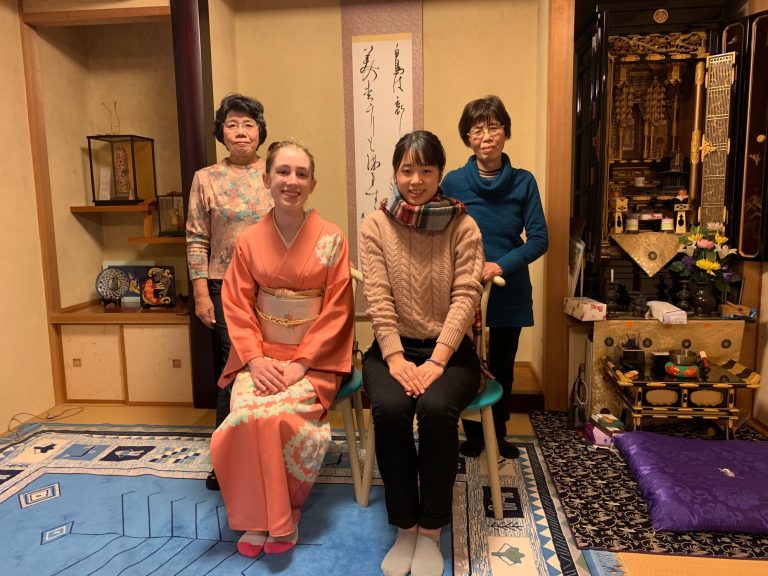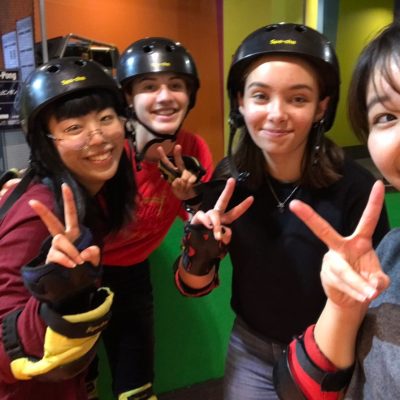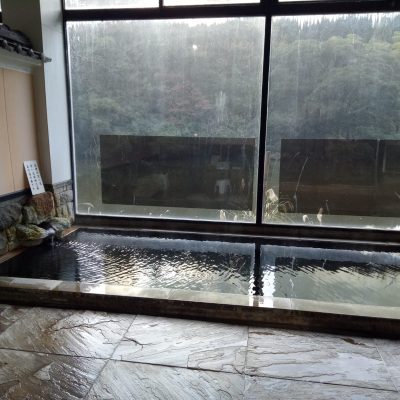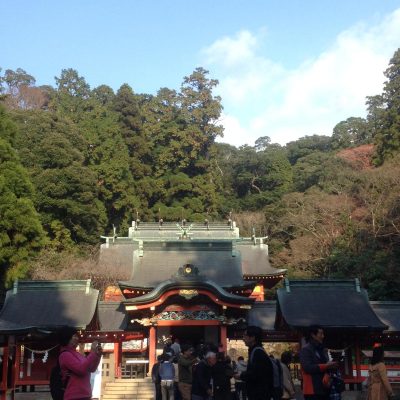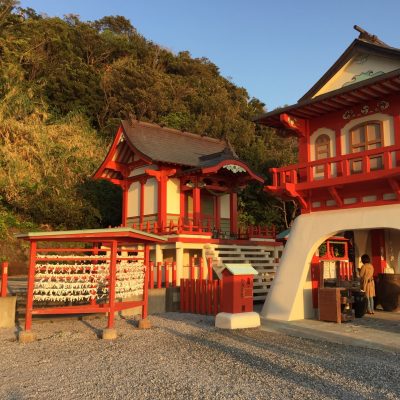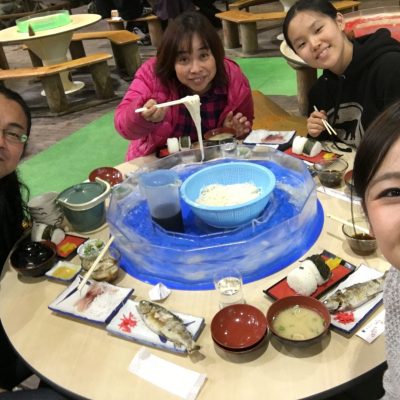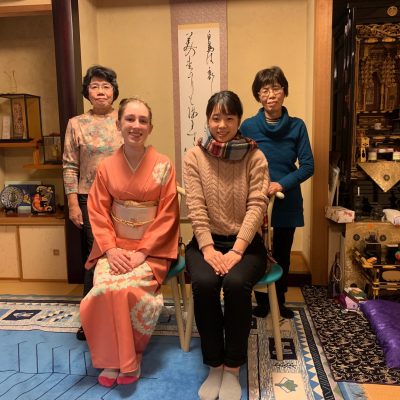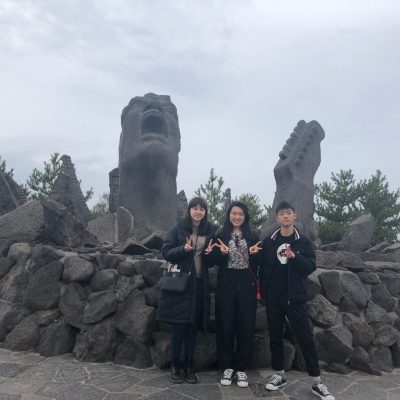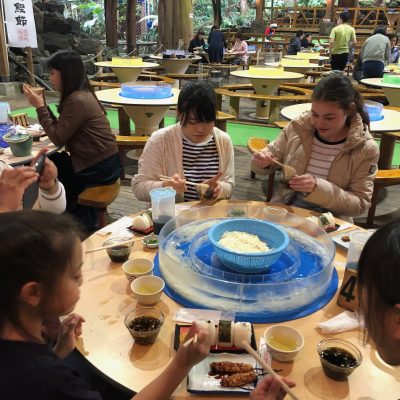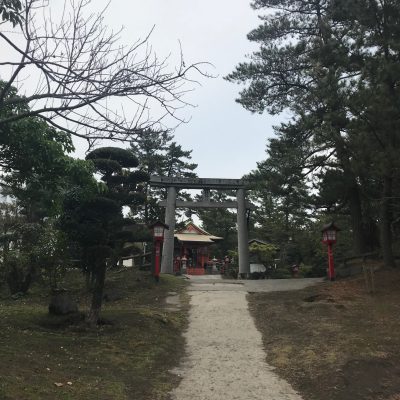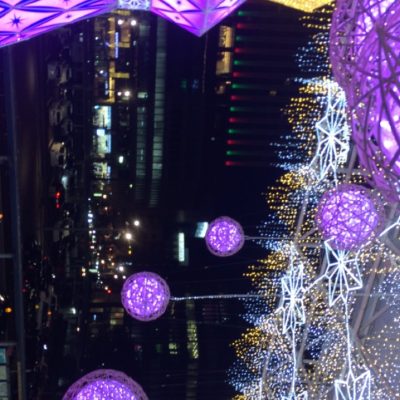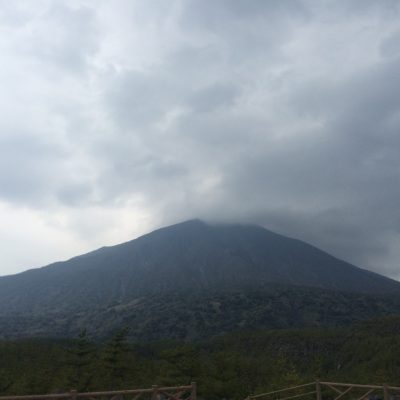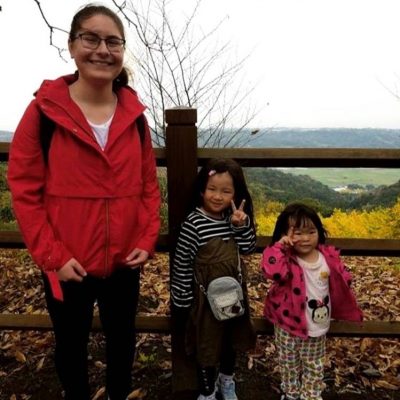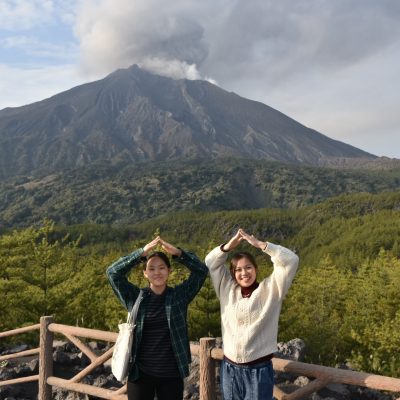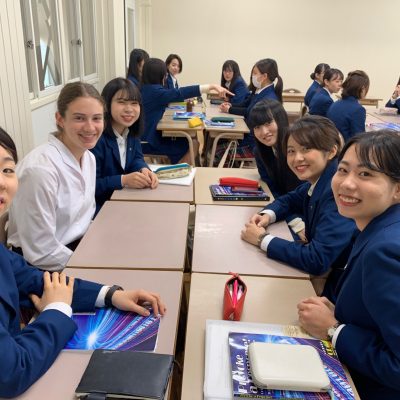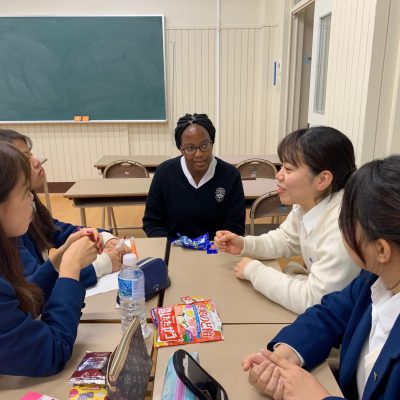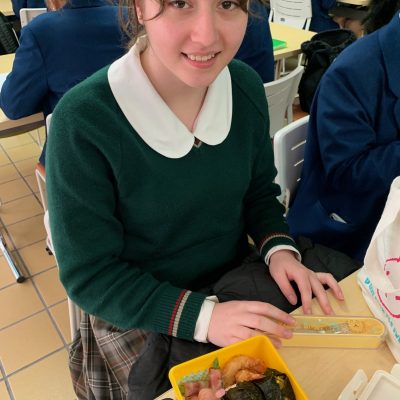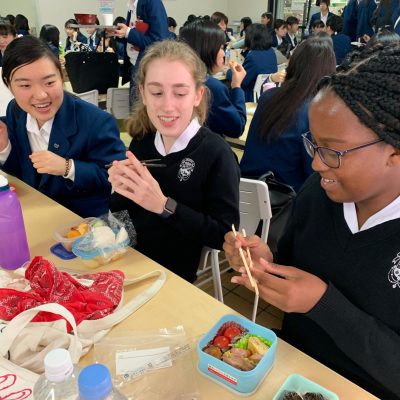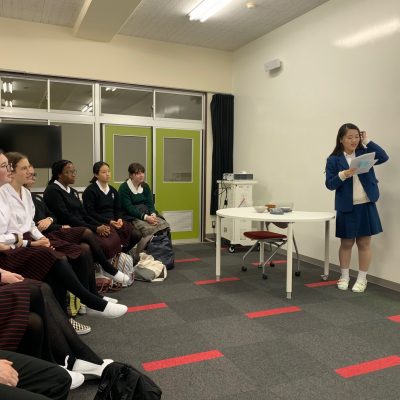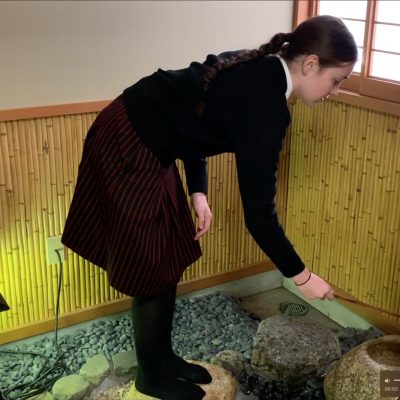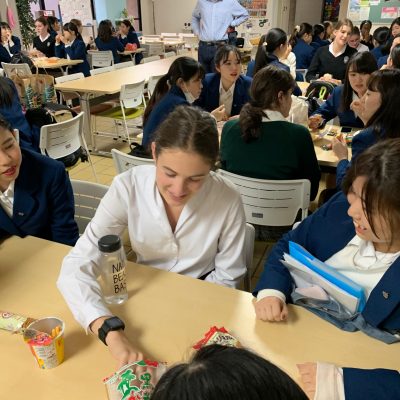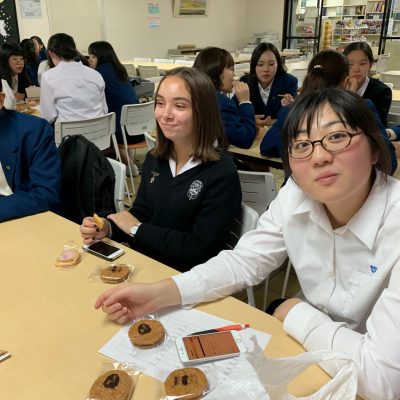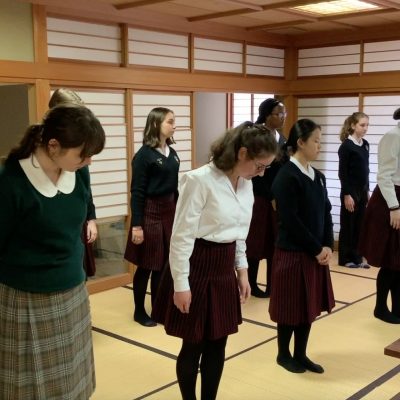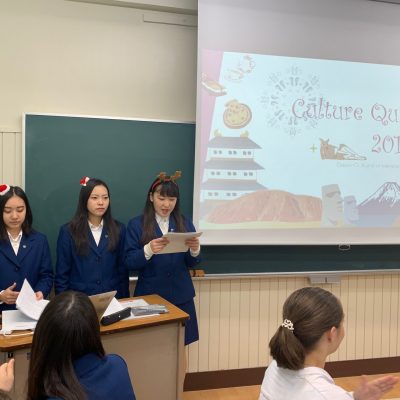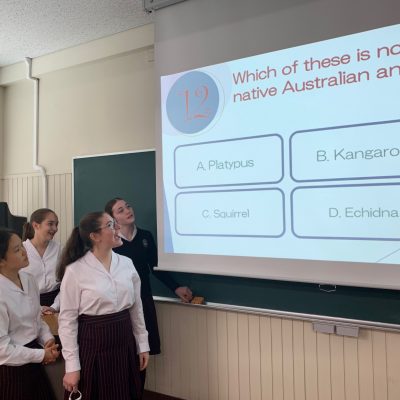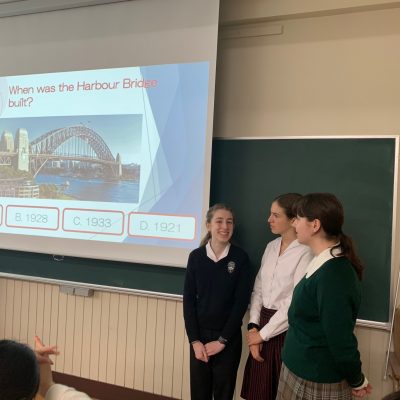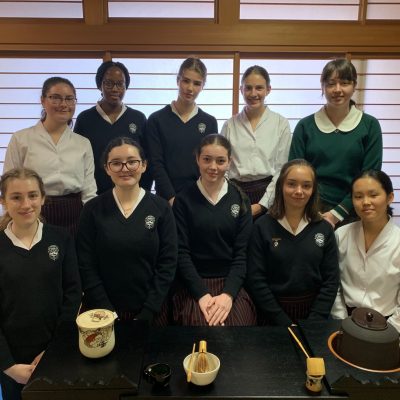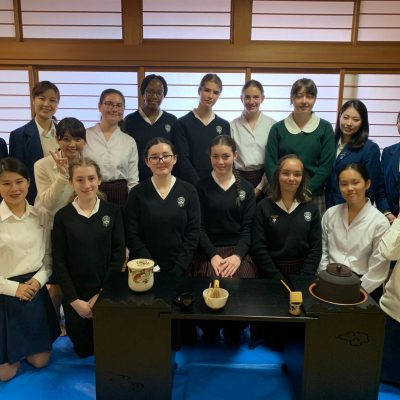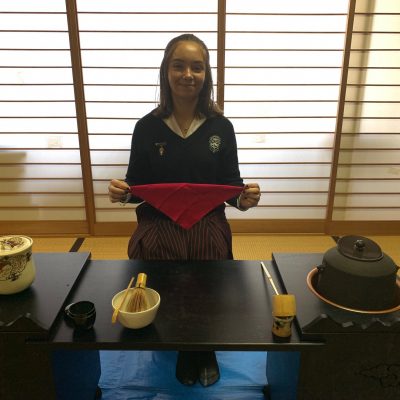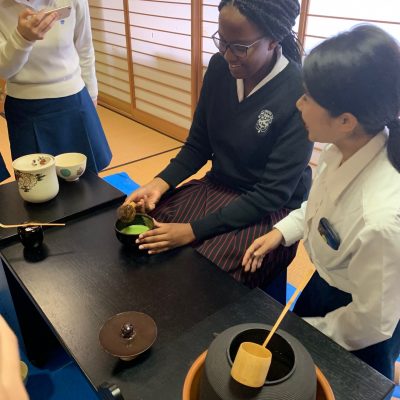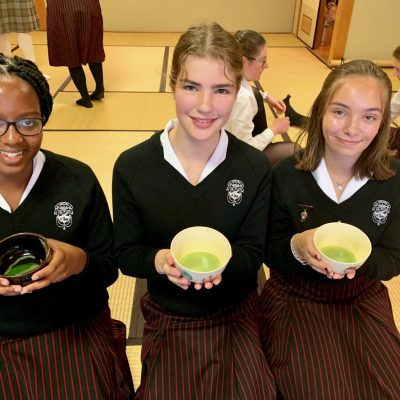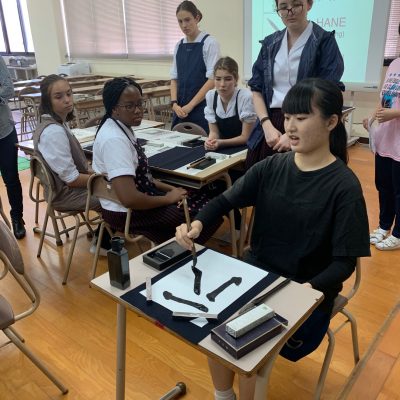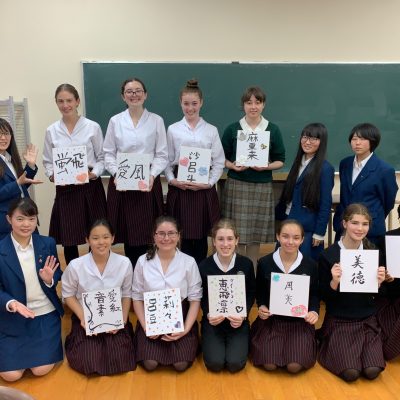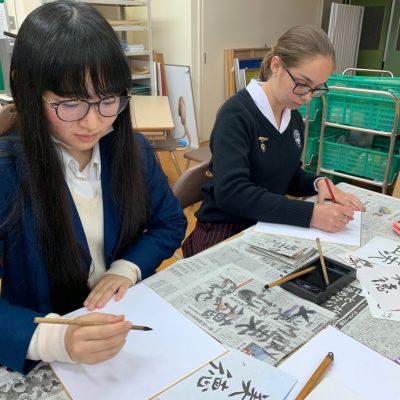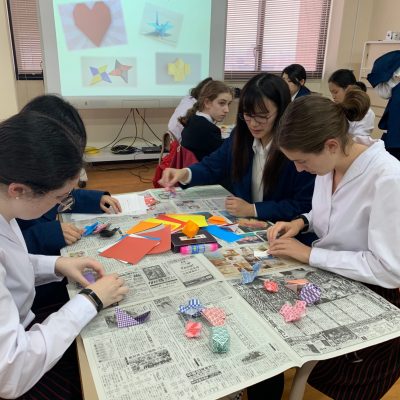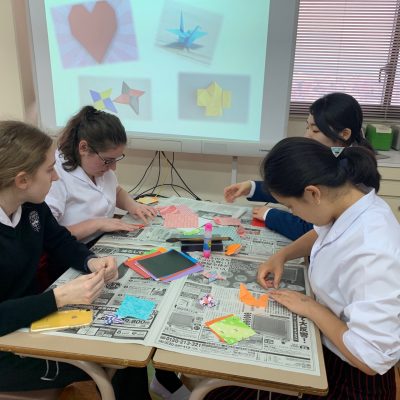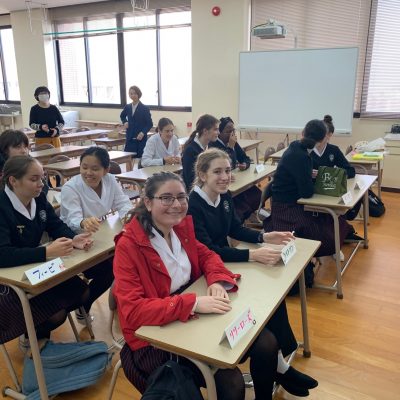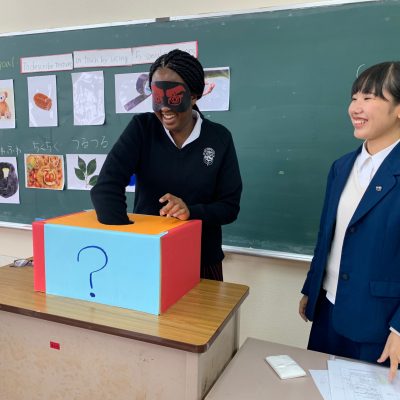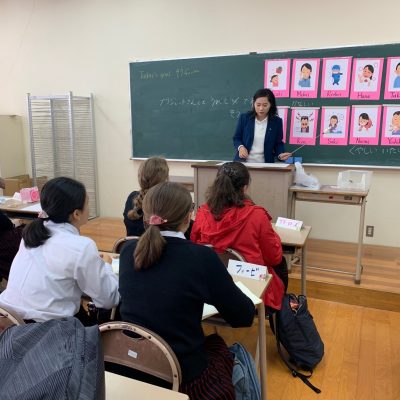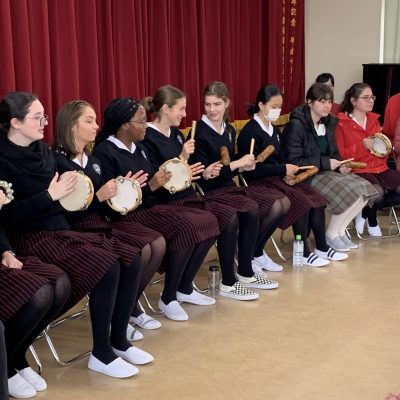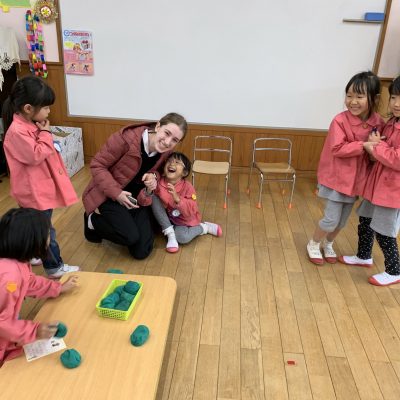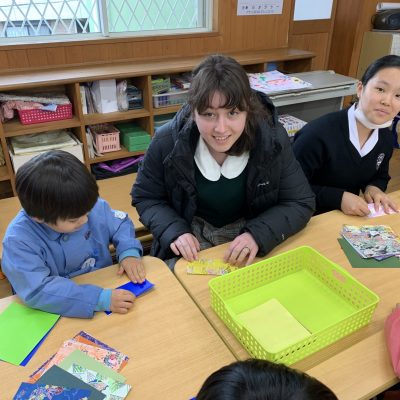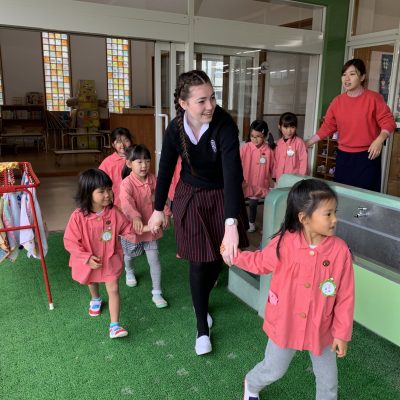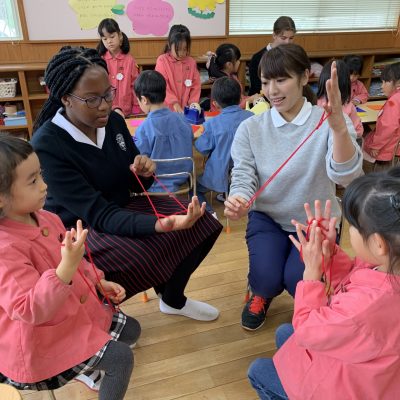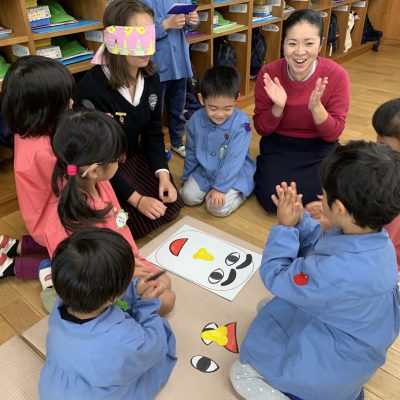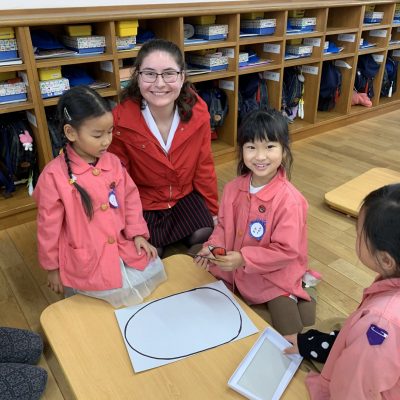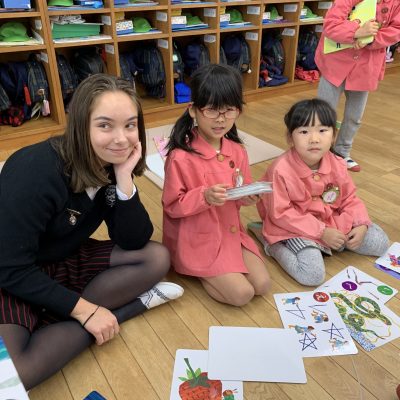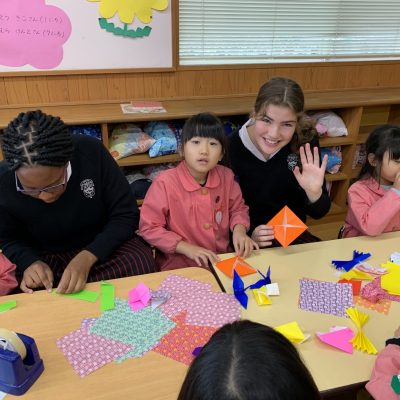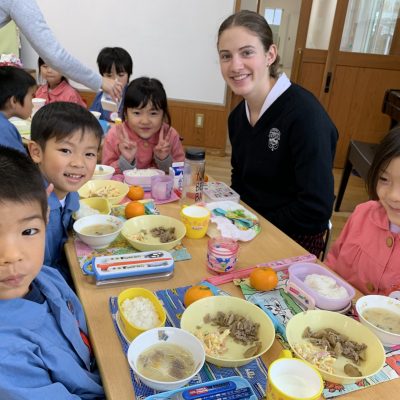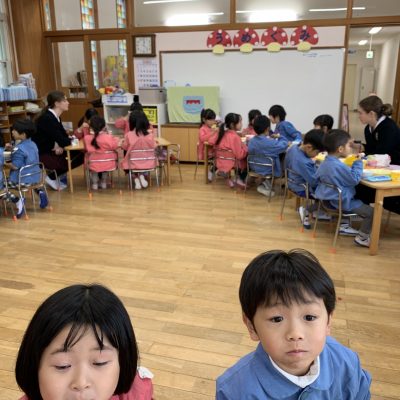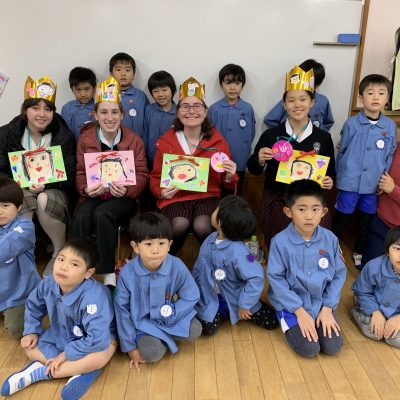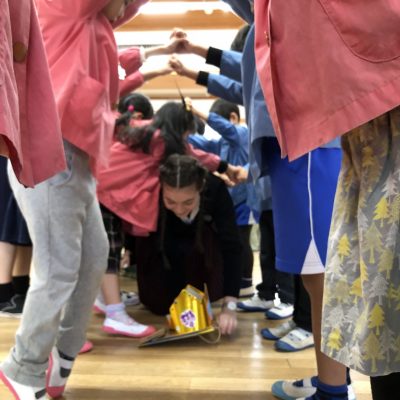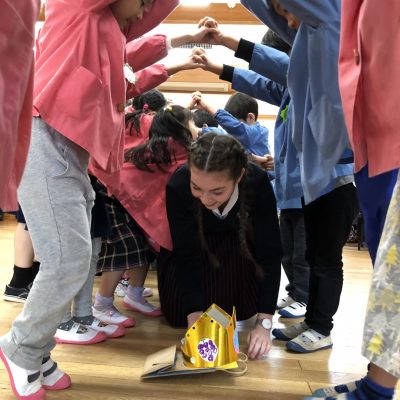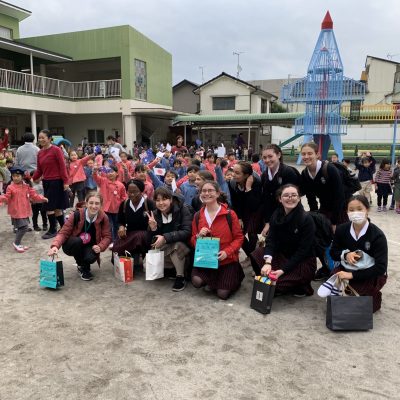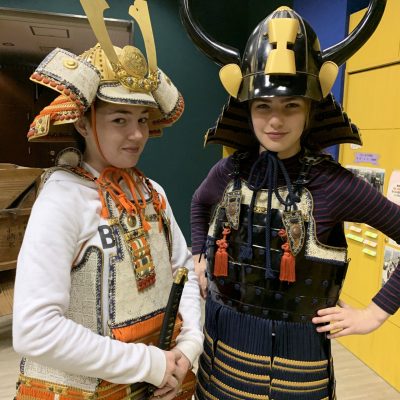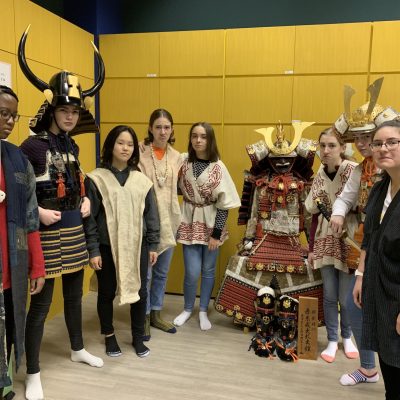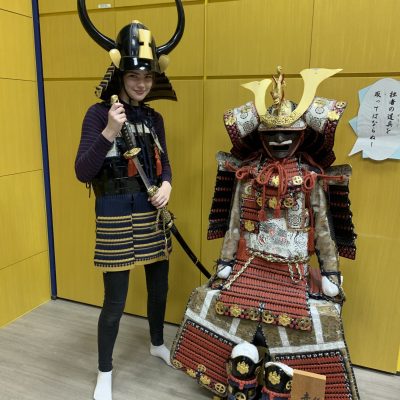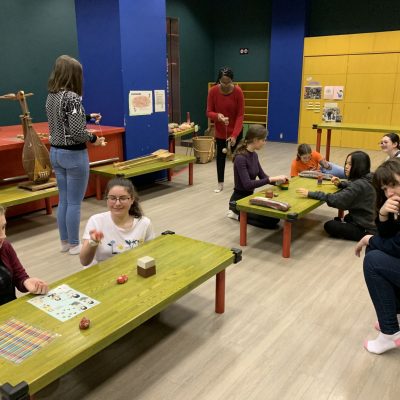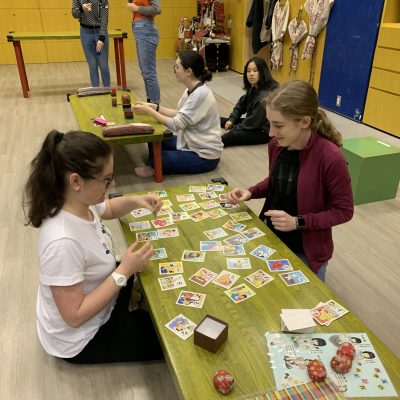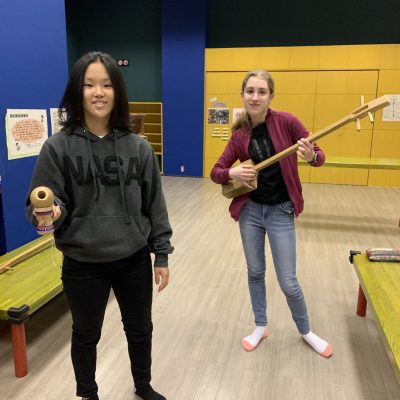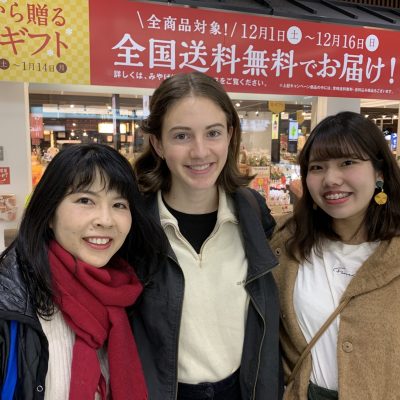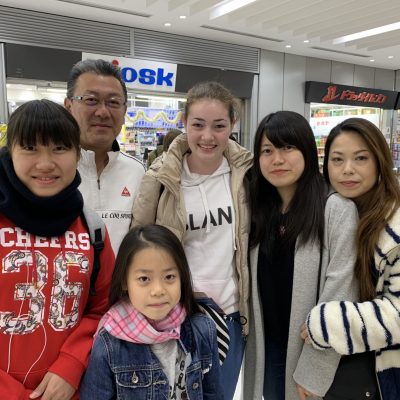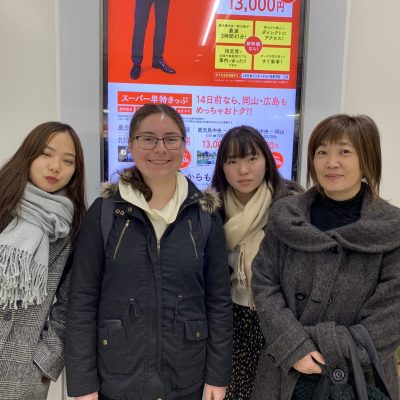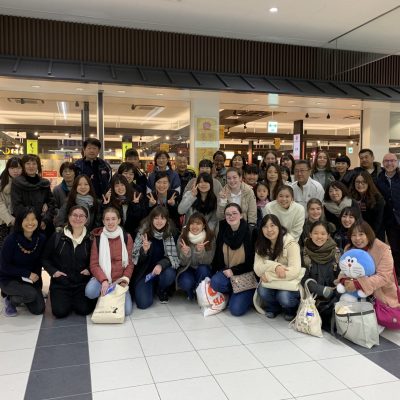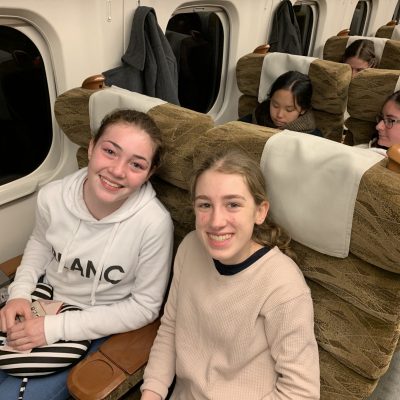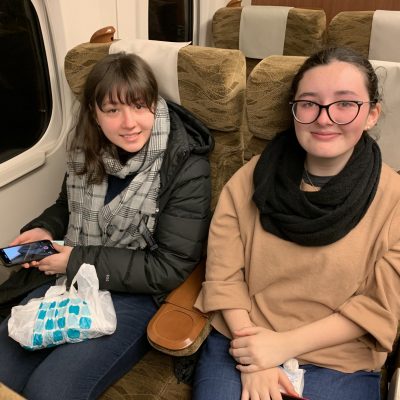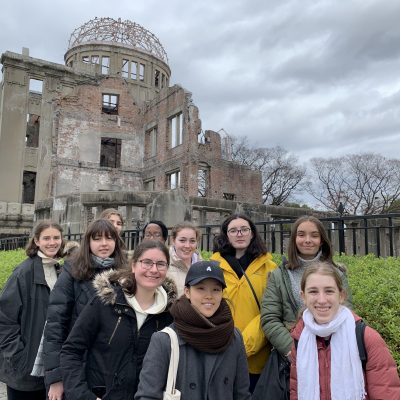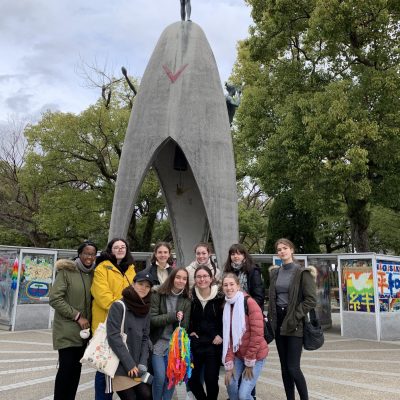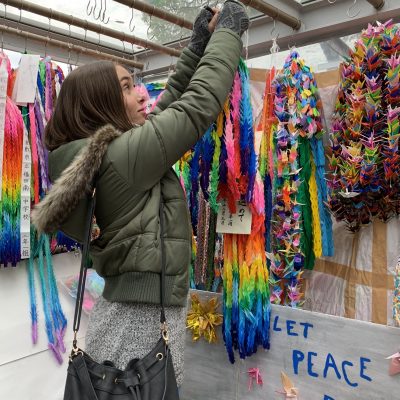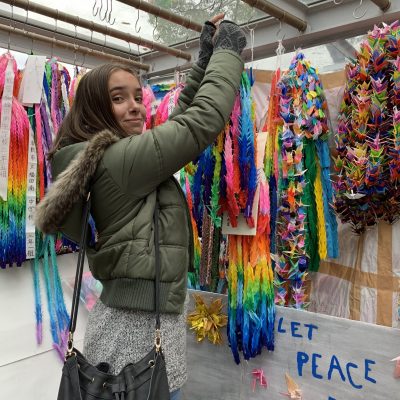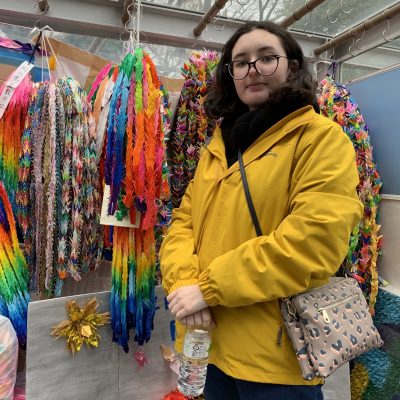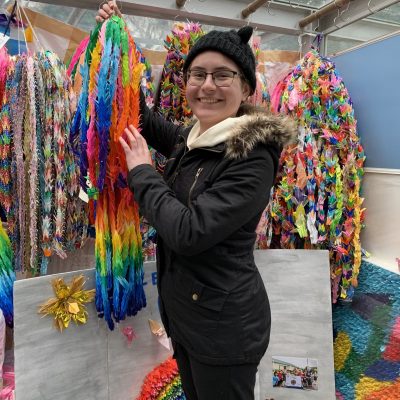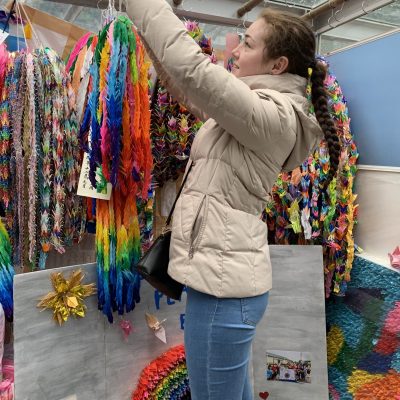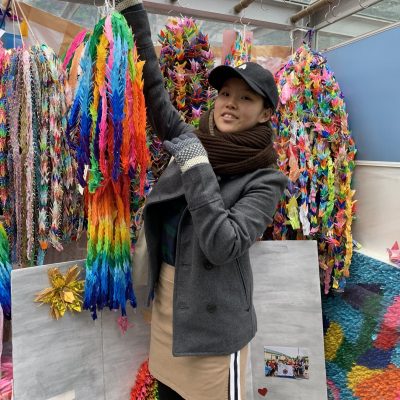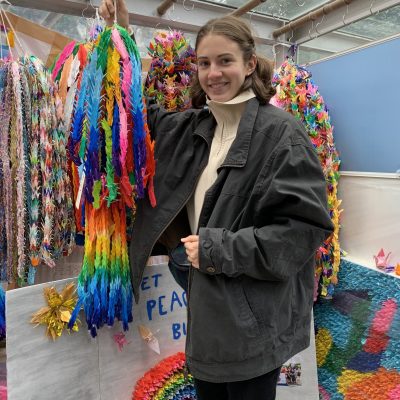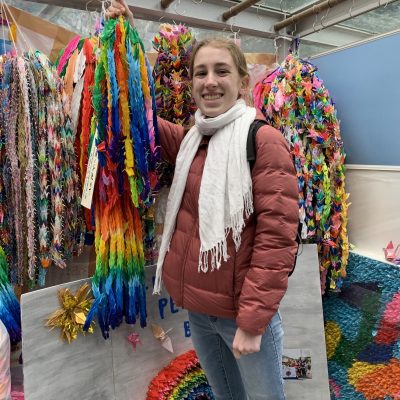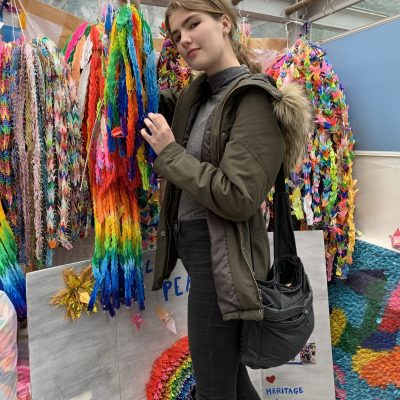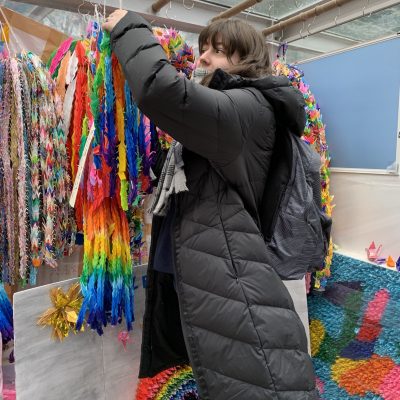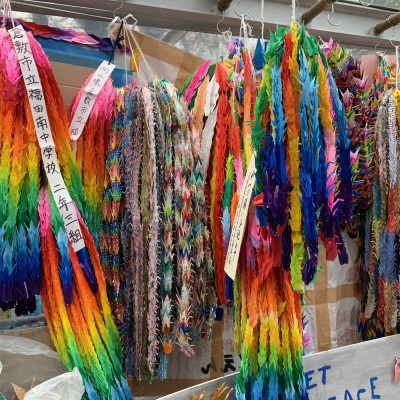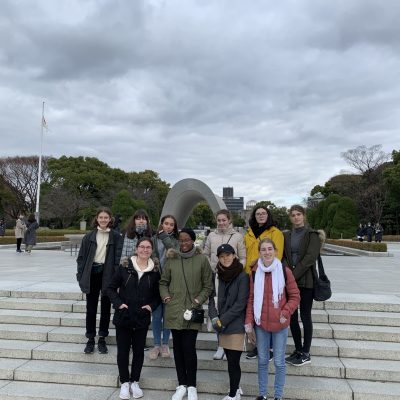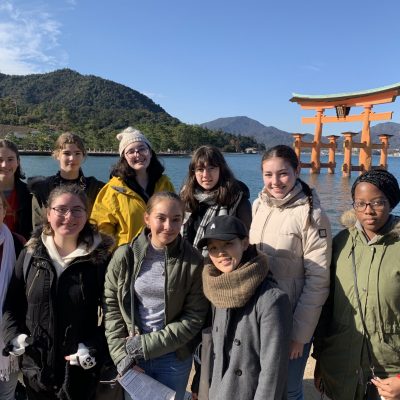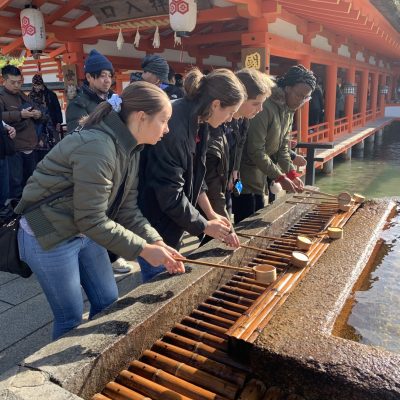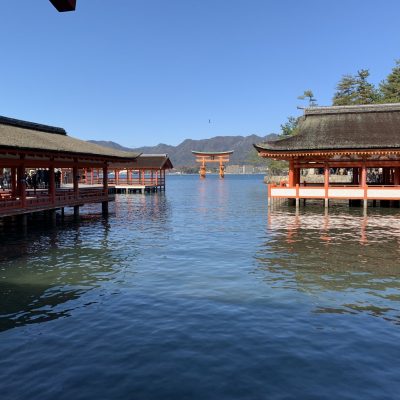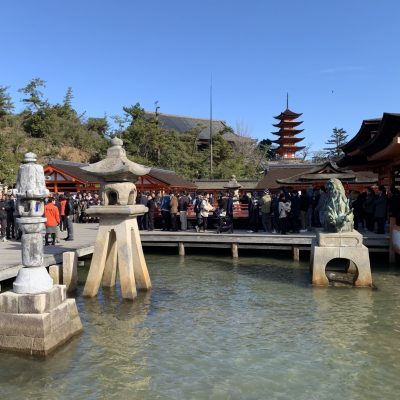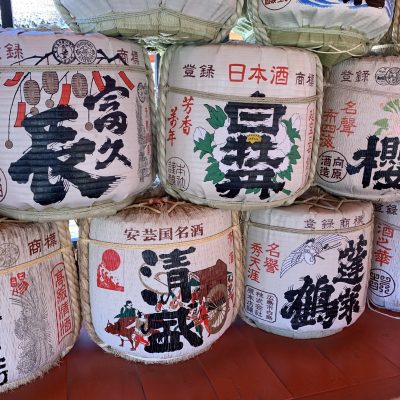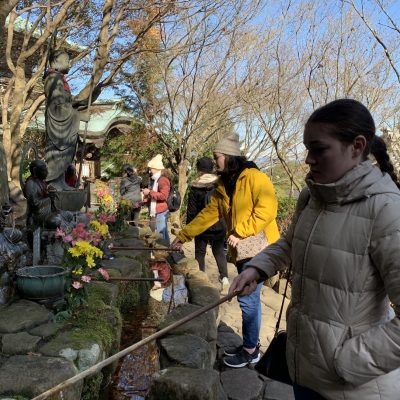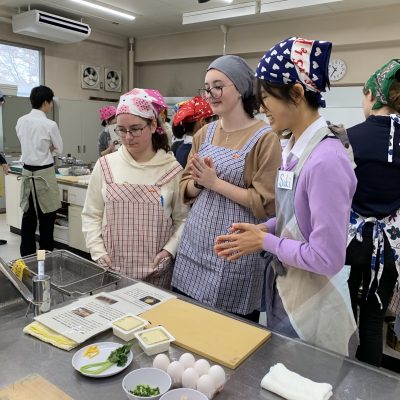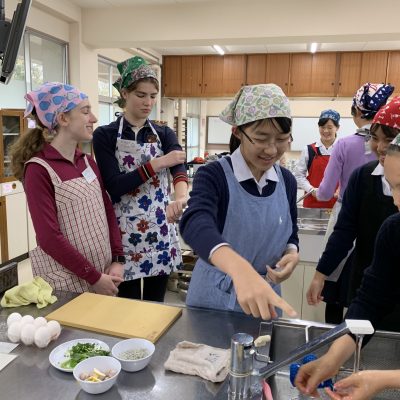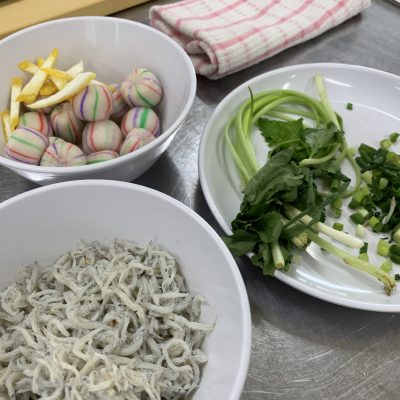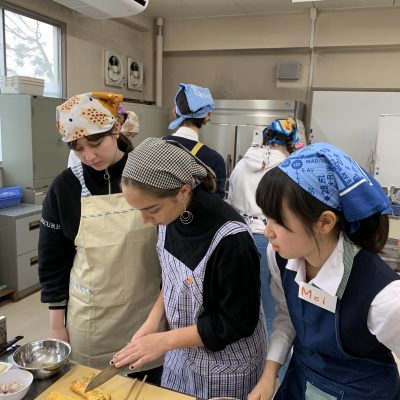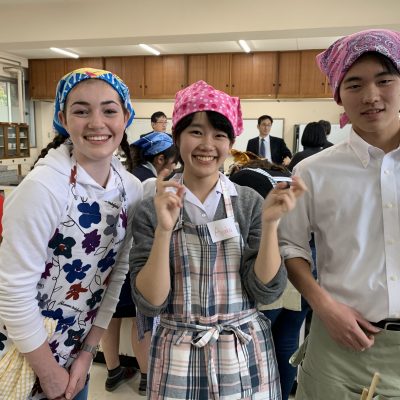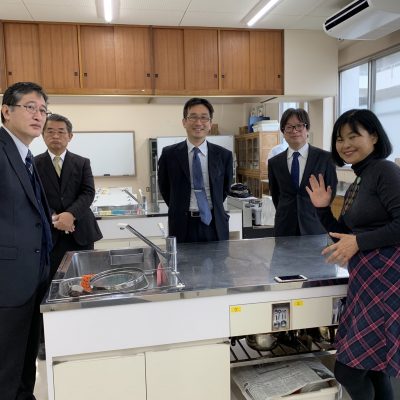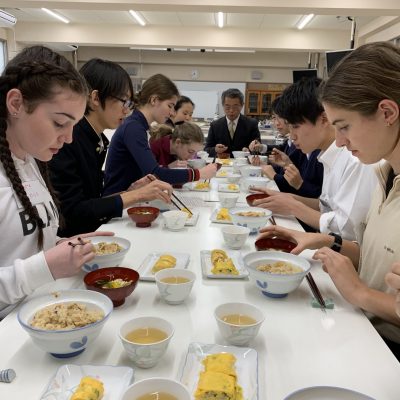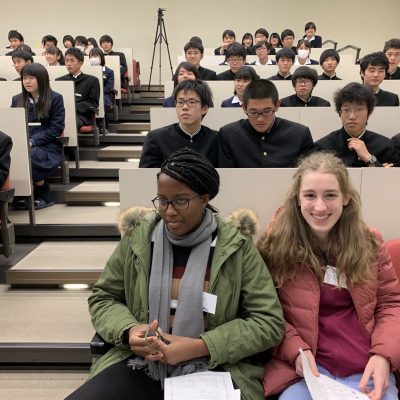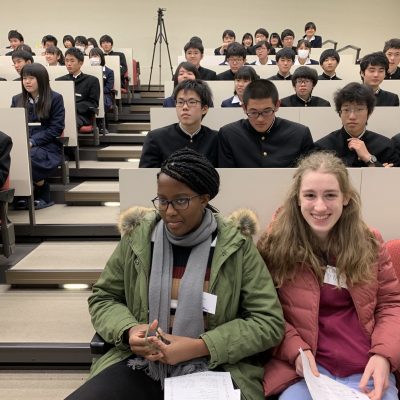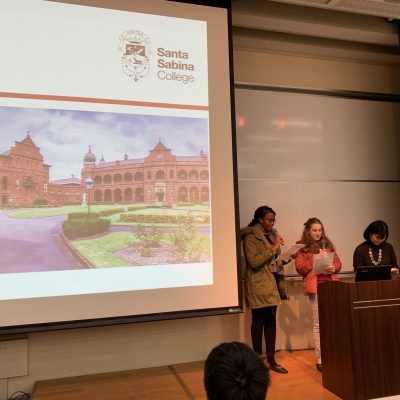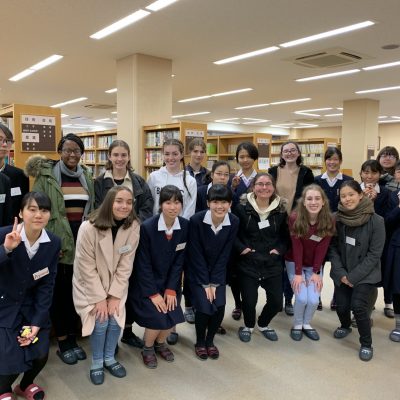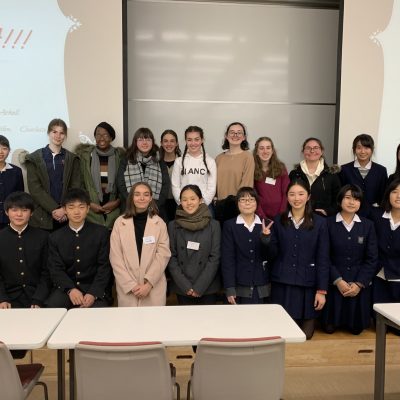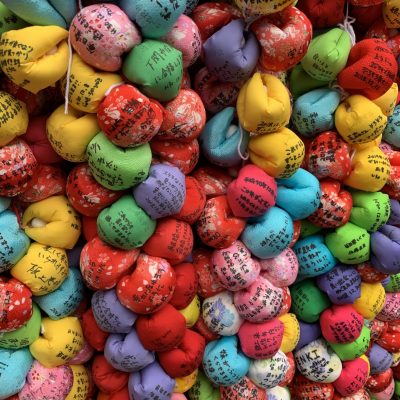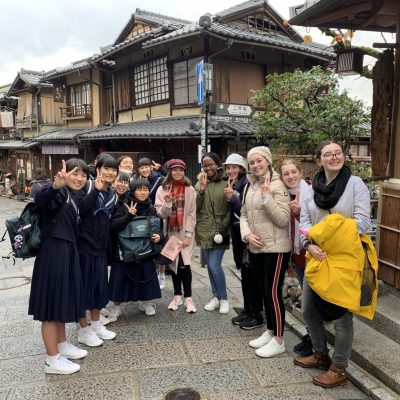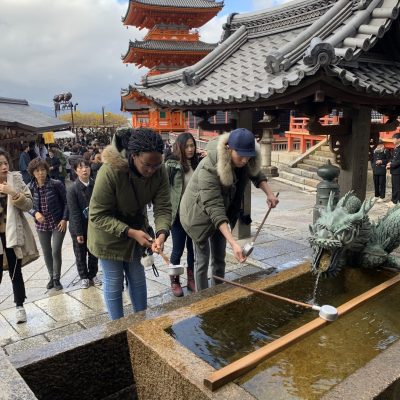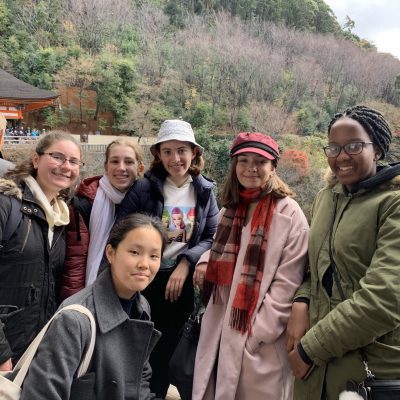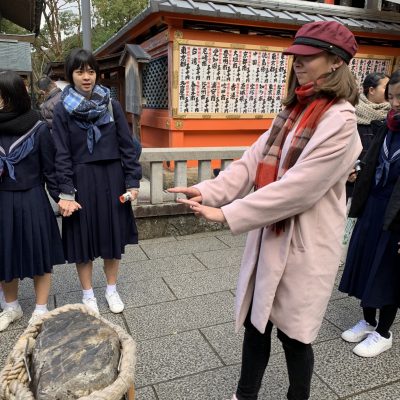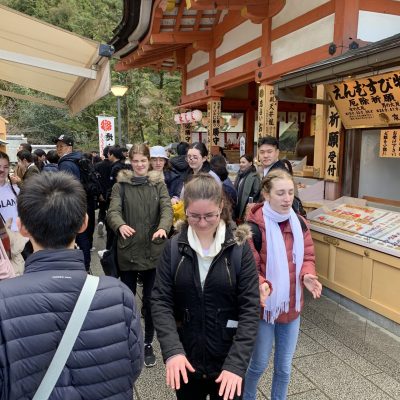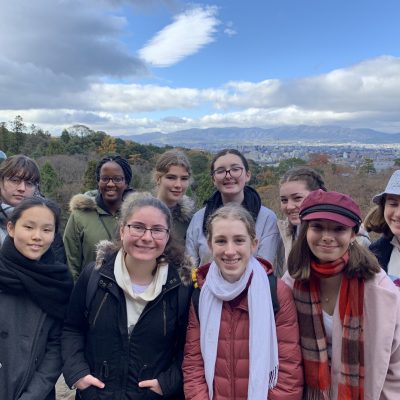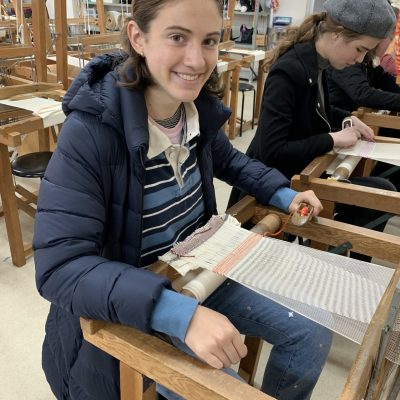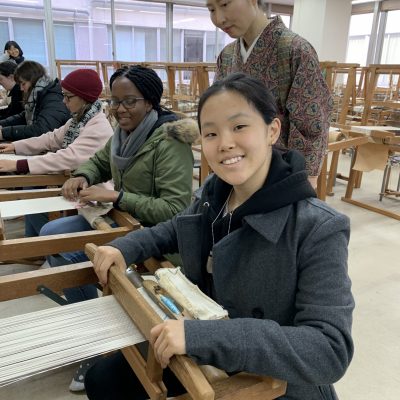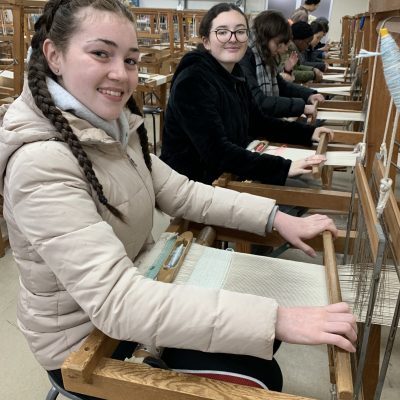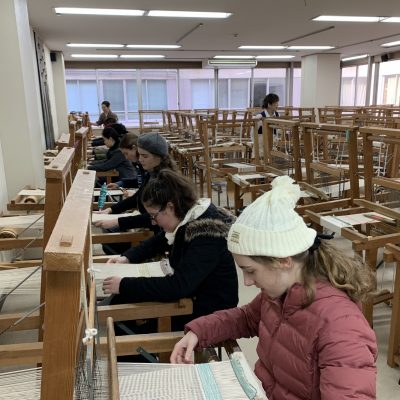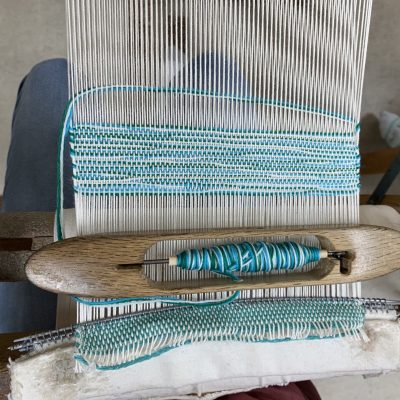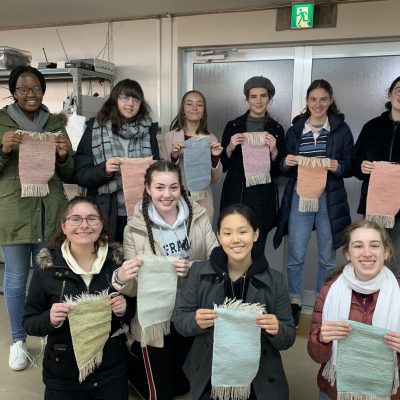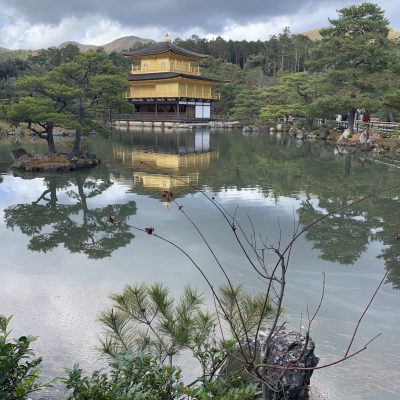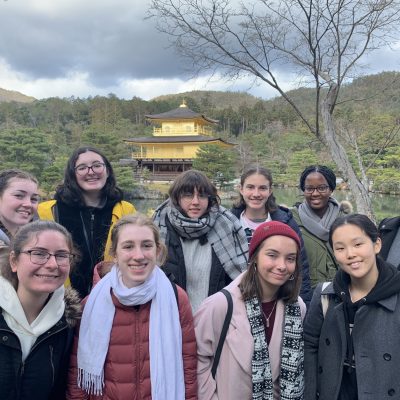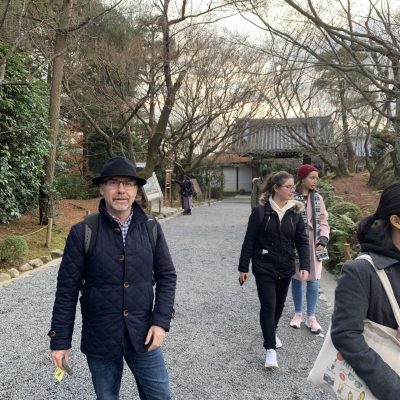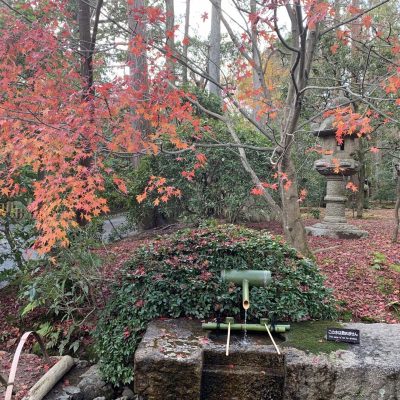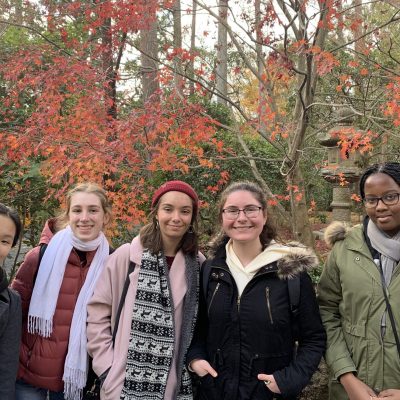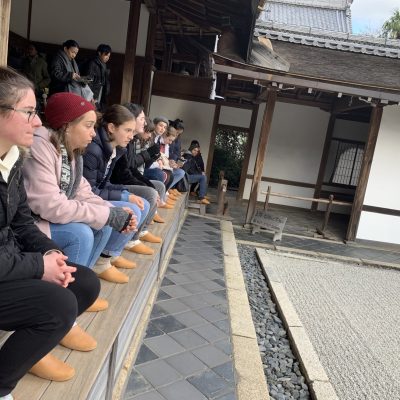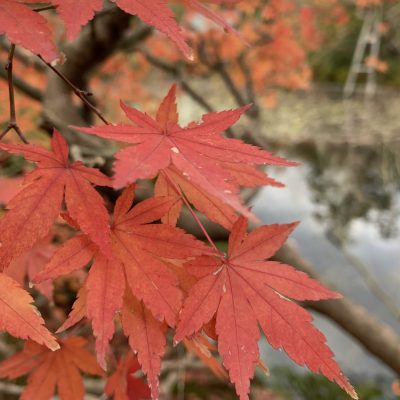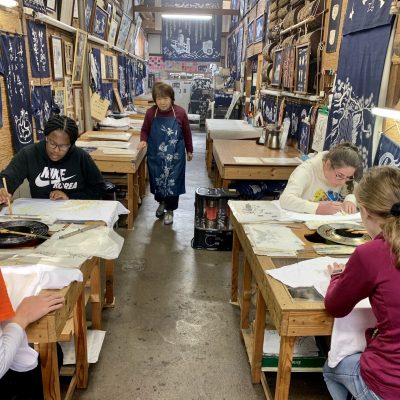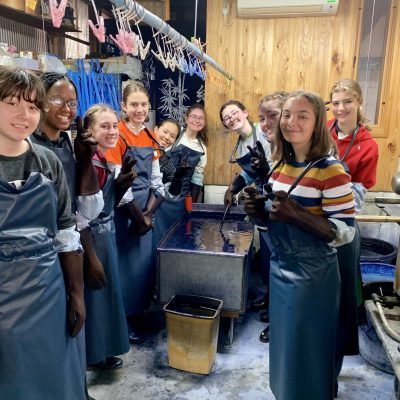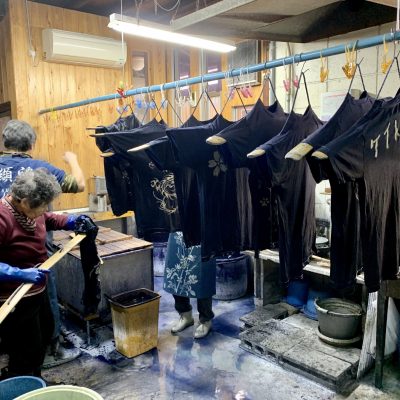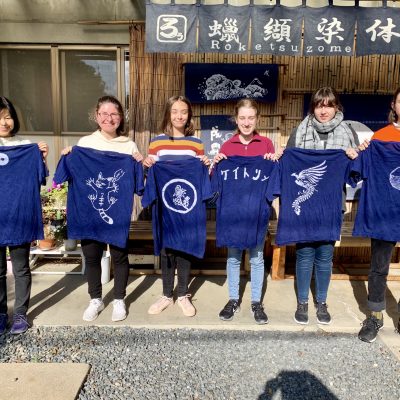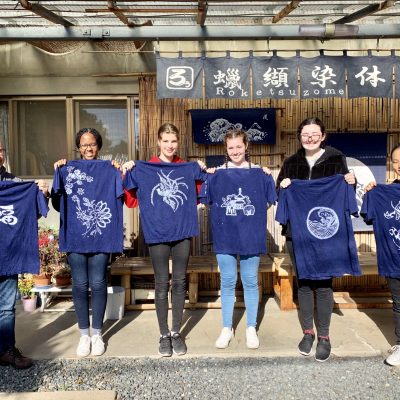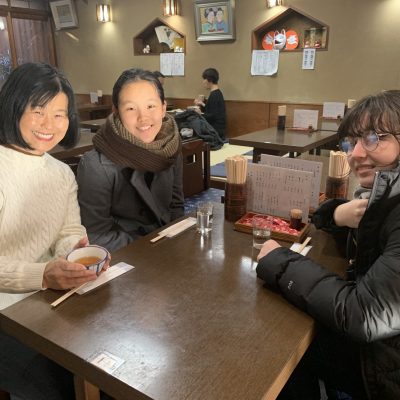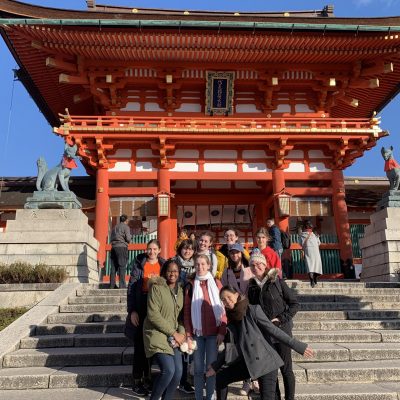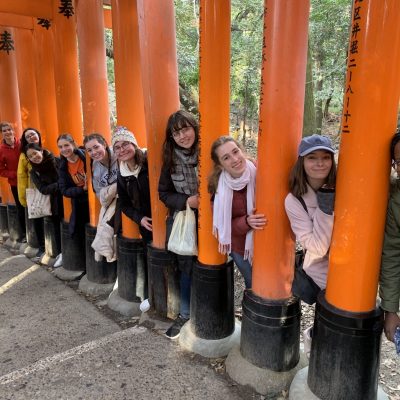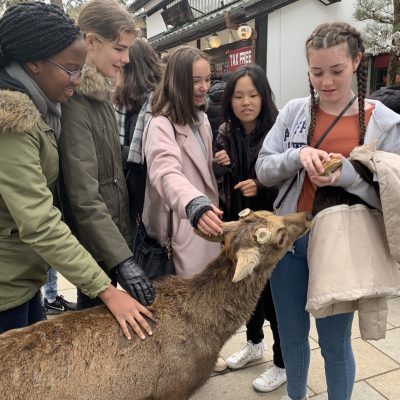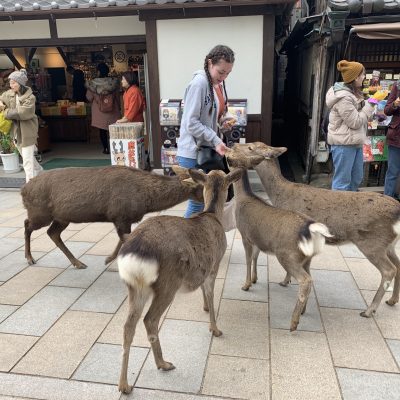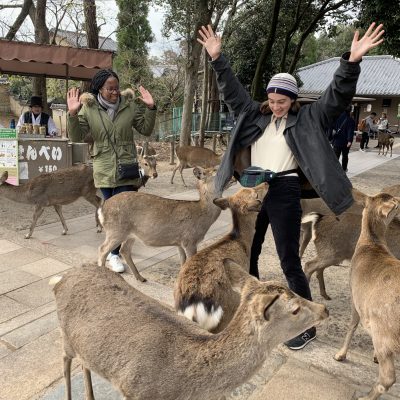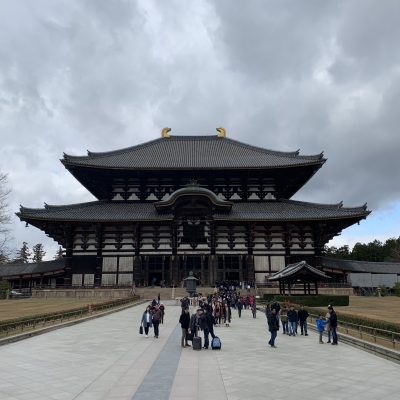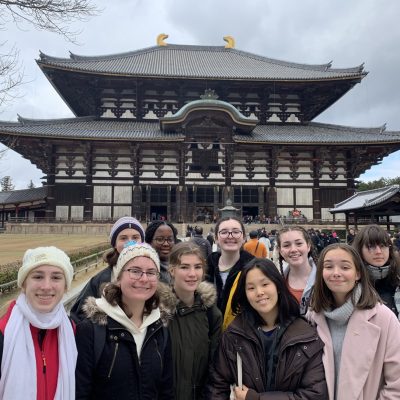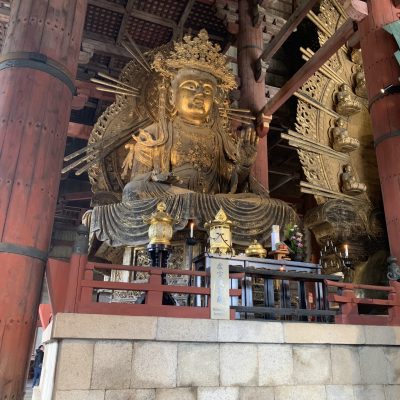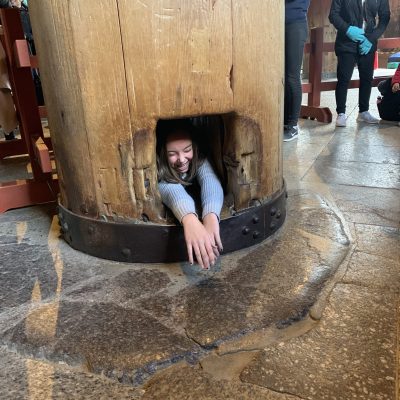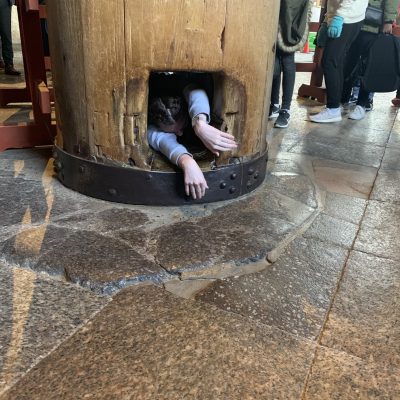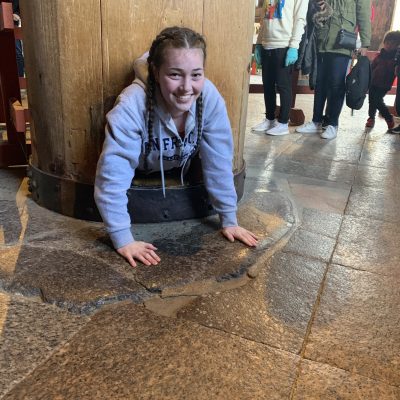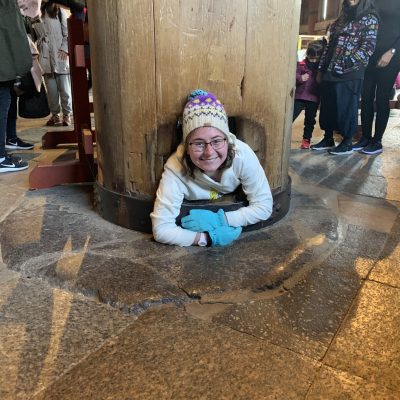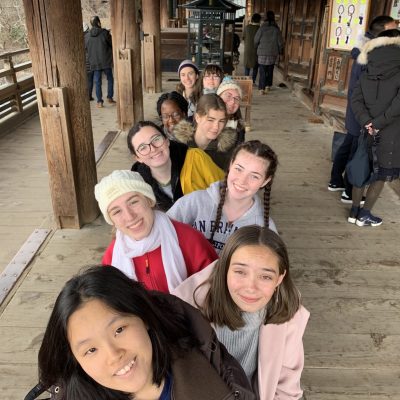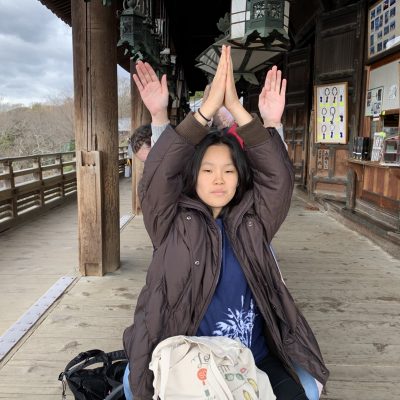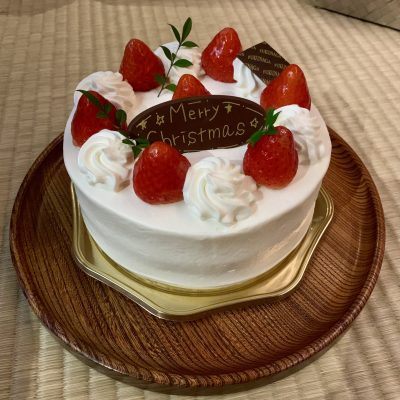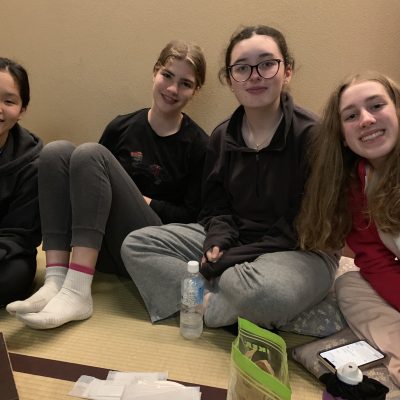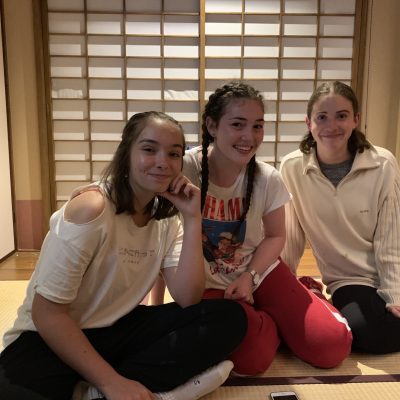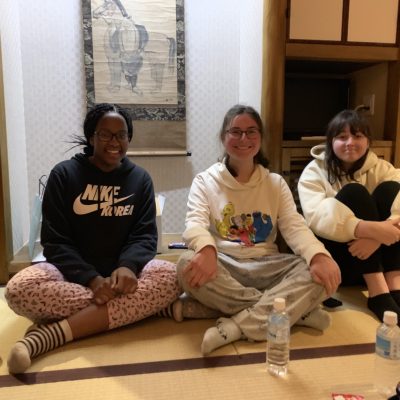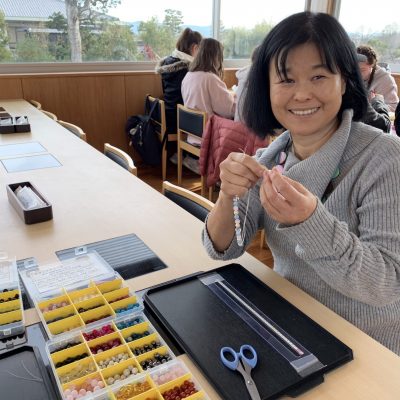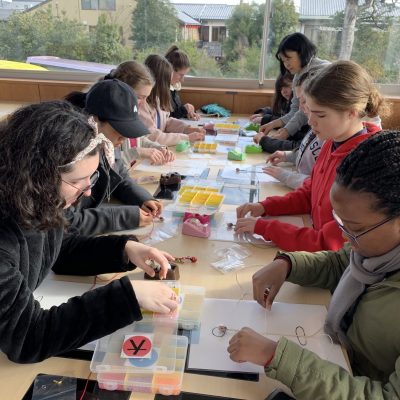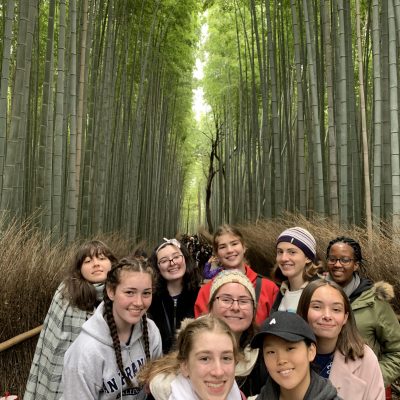Blog post 1
Written by Bridget Crick
Kagoshima
After a long flight (with surprising good plane food), we have arrived in Japan! Another flight, obento box and bus ride later, we are at our sister school, Immaculate Heart College, in Kagoshima. To our left, students in blue are sweeping and brushing leaves off the footpath (as we have arrived during the designated cleaning time for the day), and to our right is… “Sakura-jima”… an active volcano! We then have a tour around the immaculate school, eating Tim Tams and conversing with the students in Japanese. It is then time to meet our host sisters! My host sister’s name is Mayu, and together we went to her house in Kirishima, which is approximately one and a half hours from the school. I then met the rest of my host family and their incredibly cute dog Leon! My host family is very kind, and took me to many places over the weekend, including two Shinto shrines and an onsen!
Blog post 2
Written by Mara Dusevic
Kagoshima
During my stay in Kagoshima so far my host family has been taking me to many different spots across the city. On Saturday although the morning was spent playing games we visited some popular stores in Kagoshima’s City. We didn’t get much but it was fun to look around and get to know my host family. Afterwards when we were going to head home we decided to stop by the marine port in Kagoshima. Together we took some photos of the city and Sakurajima, the active volcano across the water. Afterwards we saw a bunch of lights set up for Christmas and also decided to stop by and take some photos.
On Sunday we all woke up around 9 o’clock to head to Sengan-en, a garden that is owned by a famous family in Kagoshima who have opened it to the public. There we were greeted by a sumo stage and followed small crowds of people through small shops. On our way we were surprised to see a large line of Japanese people wearing traditional clothing and some were carrying bows and arrows. The day we visited Sengan-en was also the day Kusajishi-shiki (Traditional Archery) takes place. It was exciting to watch but while we waited for the ceremony prior to the archery we walked around various parts of the garden. From the gardens you can also get great views of Sakurajima but on the day you couldn’t see much due to the fog. The ceremony was very long but interesting as the men shooting the old-fashioned bows and arrows are clearly trained to know to do this. I really enjoyed it.
After visiting Sengan-en, my host family caught a ferry where we took their car on board to visit Sakurajima. It was a busy day when we used the ferries with us waiting in line for a very long time. Like most people in the Japan Study tour we visited the island but my host family thought it would be good to have a meal and make our way one of the many observatories around the volcano. There we took some photos together and of the volcano but also bonded through our same taste in music. On the way down we got lost and stumbled upon a rock statue of a man and a guitar. My host family were surprised to see it also prompting more photos. As we slowly made our way back to the harbour we stopped by various spots along the way including some foot baths and parks. Although we arrived home late at night after a busy day at the harbour on Sakurajima we all enjoyed the day enjoyed spending time together.
Blog post 3
Written by Lily-Rose Iaiza
Kagoshima
Japan never fails to deliver great experiences such as an opportunity to attend classes in a Japanese college. We were able to discuss current issues that impact girls our age in current society. Some of the Japanese students from Kagoshima Immaculate Heart College taught us about Japanese etiquette. Who knew that there are so many chopstick taboos in Japan?
We were able to try out our newly learnt skills in the tatami room. Some of the things we learnt included how to remove our shoes properly before entering the room and how to walk on the tatami mat. Did you know that if walk on that black lines of the tatami mat it is seen as stepping on your ancestors? Also, hidden ninjas could stab you with a katana from underneath. While in the tatami room we learnt about the Chyozuya and how to use it properly. This is important because when you enter a shrine your hands and mouth must be purified.
We ended the day with interactive English where we played games like Pictionary and hangman with a multitude of Japanese snacks at our disposal to get to know other Japanese students better and help them improve their English.
Blog post 4
Written by Lily-Rose Iaiza
Kagoshima
With another day of school under our belts we have successfully enriched our understanding of Japanese culture even further. We began the day with intercultural understanding, and yes it was as interesting as it sounds! None of us knew that the tallest waterfall was in Venezuela and is not Niagara Falls. Some of our questions stumped the Japanese students but they still persevered and finished the quiz. What do you think the highest score was out of 50? Well it was 31 followed closely by 29! They were nice enough to prepare gifts for 1st, 2nd and 3rd. They also gave out participation snacks. Caitlin, a losing team member, said “that losing was not her fault but the snacks were amazing!” It’s safe to say that we all thoroughly enjoyed that class. Our second period was a free so we were able to have some time to work on our diary entries and finish off a worksheet given to us by the class. We ended the day with an information session in English about Kagoshima.
Blog post 5
Written by Mary Kimindiri
Kagoshima
To me, today was undoubtedly the most enjoyable school day of the whole trip.
We started the school day in the Tea Ceremony Room, a traditional Japanese tatami room, where we participated in a tea ceremony. We learned how to make tea from scratch and how to sit properly during the ceremony (our legs still fell asleep though).
After that, we headed to the Design Room, where some students taught us the three main brush strokes of calligraphy, and guided us as we practised writing kanji. We finished the session by creating our own piece of calligraphy as a class, using the skills we had just learned. The theme of the piece was the four seasons. Peaceful international relations is also featured within the artwork.
After having lunch with the first-year students in their dormitory, we were able to relax during the free period.
After that was…kimono!
Members of the school’s kimono club dressed us up in beautifully patterned satin fabrics, and we took numerous photos, even being able to take some outside with Mt Sakurajima in the background.
We finished off the day playing fun learning games with the first-year Japanese class, being able to communicate using vocabulary we learned in Australia as well as learning new words during the session.
Blog post 6
Written by Mary Kimindiri
Kagoshima
Today, our last school day, was a very interesting day.
After lunch and cleaning time, we had a free period, which we spent preparing for our visit to Hiroshima and practising new vocabulary.
After the free period was a calligraphy/origami session in which other students taught us how to make various shapes (paper cranes, hearts, shuriken, etc.) We then wrote our kanji names in calligraphy on card paper, and used the origami to decorate.
Blog post 7
Written by Agnes Lee
Kagoshima
We are not morning people.
However, this morning was particularly exciting as we prepared to visit a local kindergarten. Upon being welcomed by over 300 3~6-year-old kindergarten students, we were dumbfounded by the accuracy and patience they displayed as they performed Aida’s Triumphal March. In fact, our mouths could barely close.
We also had the enjoyable opportunity of exchanging nursery rhymes, such as “Twinkle twinkle little star”, ‘I’m a little teapot’ and “Baby shark”. Led to their spacious and pristine classrooms, we took the time to entertain one another by playing some Japanese games and folding origami. The kindergarten children were extremely kind and considerate. These traits were highlighted when lunch was being served to us. Their table manner was cut to precision, and their concern for other peers, such as concern for nutrition or portions were displayed. After emotional attachments and difficult “goodbyes”, we headed to Tenmonkan.
Tenmonkan is a famous shopping area in Kagoshima, and deserves to be on your travel bucket list. In Tenmonkan, we were able to taste Japan’s most famous “shiro kuma” (sweet shaved ice). Even though it was a freezing cold day, our spoons did not stop scooping! After our delightful experience, we were granted an hour of exploring time. Tenmonkan was packed with convenience stores, clothing stores, stationery stores, food stalls and traditional Japanese clothing stores. This shopping experience taught us that Japanese people hold onto their culture as they advance technologically and socially, unlike most other countries.
To wrap up our school program, we were presented with an award recognising completion of the week’s course. We feel grateful for the experiences provided by Immaculate Heart College and hope to use our knowledge gained in the future.
Blog post 8
Written by Agnes Lee
Reimeikan
There is nothing better than a hands-on experience within a country you have never been to. Today, we did just that. Reimeikan is a museum of Japanese arts, festivals and culture which is still well preserved within the rapidly advancing Japanese society. Friendly staff guided our study tour group to an intriguing room, packed with traditional toys, games, instruments and even samurai armour (torii) and a traditional sword. To be given the chance to wear the samurai armour, we had moved our hands rapidly in a gruelling game of “scissors, paper, rock”. The two winners were geared up as samurai complete with a helmet, body armour and katana (traditional Japanese sword), and basked in sheer joy. On the other hand, the unfortunate victims of the two samurai were dressed in peasant clothing, which was a very simple sleeve of fabric pulled over our bodies. We were grateful for the time granted for us to explore more of the Japanese museum.
From festival, housing, food, dialects and sword displays, the museum portrays the ongoing traditions and arts in Japan, and will likely never be forgotten from Japanese society.
As it was also our last day of homestay, we were then able to spend quality time with our beloved host families. We are extremely grateful for all the time, effort, consideration and love that they put into our activities, food, travels and actions. We pray that we will be able to meet them again.
Blog post 9
Written by Charlotte Lowe
Kagoshima to Hiroshima
Blog post 10
Written by Charlotte Lowe
Hiroshima
Today was a full day of sight seeing. The places we went to really took my breath away and really showed off the best of what Hiroshima has to offer. Miyajima is an island full of beautiful shrines and temples. I felt really calm today and it helped balance the intense amount of emotion from yesterday.
The Itsukushima tori gate was built on water to try and mimic the appearance of the りゅぐじゅ (the mythical dragon palace). The itsukushima shrine is dedicated to three Munkata goddesses. They are worshipped as deities of the sea, traffic safety, fortune and accomplishment. It was filled with tourists but that couldn’t take away from the beauty of the day and the shrine. We were given free time that was mainly used to eat lunch and look at the thousands of souvenir stores that flooded the main road. We then walked to an illumination. There were about four blocks of park covered in lights, in various shapes, on both sides of the streets. It was spectacular and after a full day I think we were all very exhausted.
Blog post 11
Written by Caitlin Murphy
Fukuyama
Once we arrived, we were taken straight to the kitchens where we learnt how to make a delicious Japanese meal. We were split into small groups with two Japanese students to help us. The first dish was tamagoyaki. This was a kind of rolled omelette which included eggs, shallots and shredded fish called katsuobushi. We each had two turns of cooking it and let’s just say my first tamagoyaki was definitely abstract. The second dish was dashi soup, which had a umami flavour. We chopped up tofu in a special way so that it bloomed like a flower when we put it into the soup. Finally, there was takikomi gohan. This is a type of rice with soy sauce, chicken and vegetables.
After our delectable meal, we headed to the hall where we listened to a very engaging presentation about the school. We learnt all about the different festivals and special days. The students spoke really good English, especially as they were only Year 10 and even made some good jokes. We also sang the Fukuyama Fuzoku song, even though out of all of us only Ms Kuzi really knew the tune.
Then, Mary and I did a presentation in Japanese about Santa Sabina, and the things that make it different from schools in Japan such as the House colours, Dom’s Day and Tallong. We were quite nervous after seeing how good their English was but everything went smoothly. We all then decided to sing them a bit of our own College song.
To finish off the day, we got to speak with the Japanese students who visited our school last year. It was great to see some of them again and we had some good discussions about Australia vs Japan. We even got to eat some Japanese sweets called kibidango.
After that engaging and insightful day, we got back on the Shinkansen to Kyoto.
After a western style breakfast we headed off to Kiyomizudera temple. To get to the temple, we walked through the gorgeous backstreets of Japan, desperately trying not to be distracted by the seemingly endless tourist shops. We even got stopped by some Japanese school kids who wanted to ask us some questions for an English project. After walking through the temple for a while, we walked through the Zuiguudo hall. This was a pitch black winding tunnel that you had to navigate through with only the railing as a guide. This really enlightened us on how it must feel to be someone who is unable to see and must solely rely on their other senses or someone else to guide them.
The next experience of this temple was the famous spring. This spring had three different streams, symbolising long life, success in study, and love. We could only choose two to drink from, because drinking more than that is seen as greedy. It is still a big debate as to which ones to choose.
After that, we visited the Gingakuji temple. This temple was meant to be covered in silver (as the word “gin” suggests) however it was built during a period of war and the silver was never applied. Even without the silver however, this temple was stunning. It had vast gardens including many types of moss and a sand garden meant to represent Mount Fuji in moonlight. The gardens even had a lookout over Kyoto. This was my favourite temple yet.
To end off the day, we had a delicious dinner of Tonkatsu.
Blog post 13
Written by Maeve O’Connor
Kinkakuji
Again, our early morning started in our ryokan – a traditional Japanese inn. After having our Japanese style breakfast, we headed out to make a placemat using Nishijin weaving.
In Australia, we think that on packed buses there are usually only ten people standing and all the seats are taken. In Japan, it’s a totally different story. As we experienced after weaving, the bus we caught to our next location was slightly smaller than the average Australian bus but had around 25 people standing, with all seats taken.
Finally, we arrived at Kinkakuji – the Golden Pavillion.
Kinkakuji temple was built as the retirement home for the shogun Ashikaga Yoshimitsu. His grandson, Ashikaga Yoshimasa, built Ginkakuji (the Silver Pavillion).
With kin (金) meaning gold, the top two floors of the temple are completely covered in gold.
After our walk around Kinkakuji, we had green tea and traditional Japanese sweets while overlooking a part of the beautiful gardens in the area.
Afterwards, we went on a 25-minute walk to our next location: Ryoanji. Ryoanji is famous for its rock garden – we know it sounds boring but trust us, the area was incredibly pretty due to the Autumn leaves which flourished on the last part of our walk through Ryoanji.
After heading back to the ryokan, we ended our day with an hour-long “meeting” in Agnes and Mary’s room. Here, we shared a box of なまやつはし, which is sort of similar to mochi but with a filling inside, such as red bean paste or chocolate.
Blog post 14
Written by Maeve O’Connor
Fushimi Inari
Today we went to one of the most famous tourist destinations in Japan: Fushimi Inari. We walked through the markets outside, had lunch and tried taiyaki (it was delicious!), before walking through the famous Torii gate pathways.
In the morning, we also tried Aizome t-shirt dyeing. First, we chose patterns and drawings, outlined them with wax, and then we each had a turn to dye the shirts.
We all had an obento for dinner, before meeting in Bridget, Mara and Phoebe’s room at the ryokan.
We all thoroughly enjoyed the day and hope to see the Torii gates again!
Written by Pheobe Trainor
Todaiji
Blog post 16
Written by Cate Wheadon
Arashiyama Bamboo Forest
Today was our last day in Japan. Everyone was so sad to leave because of how much we had learnt over the past two and a half weeks. We have all developed a greater appreciation for the Japanese culture through the homestay experience and visiting many significant temples and shrines that enriched our understanding of Japan, having lots of fun along the way.
We started our day with a challenging yet rewarding craft activity, in which we used string and beads. Everyone was very pleased with their end product and some even put them on their phone cases as decoration.
After that, we had lunch in a street with many small restaurants and traditional Japanese desserts. Everyone enjoyed their final meal in Japan. We then made our way to the Arashiyama Bamboo Forest, which we walked around in for a little bit, admiring the masses of bamboo and taking in some of our last moments of sightseeing in Japan.
On our way back to our ryokan, we stopped by a temple across the road. There was a very large main temple with a few smaller ones scattered around the grounds. The familiar smell of incense greeted us as we walked inside of the temple, and the immediate reverence and serenity of people deep in prayer made us feel very calm. Visiting these sorts of temples shows the dedication to faith and worship that followers have towards their higher power.
And then finally, it was time for us to grab our bags and say goodbye to the lovely workers in the ryokan for their hospitality and generosity during our stay. We thanked them many times and then made our way to the airport.


